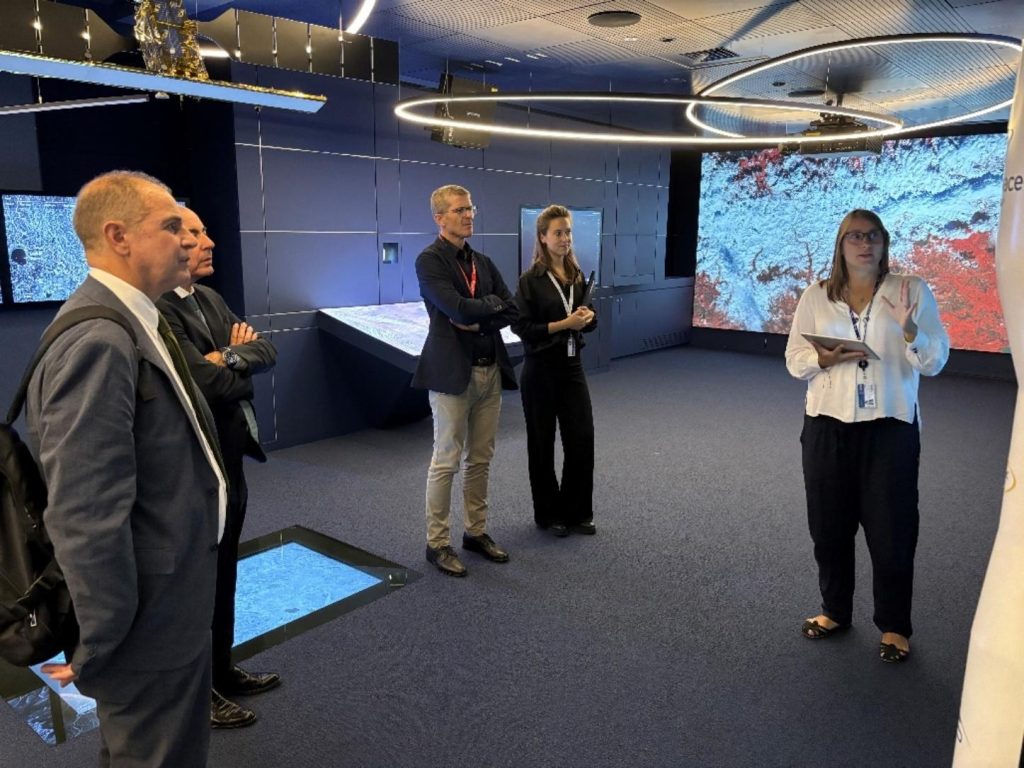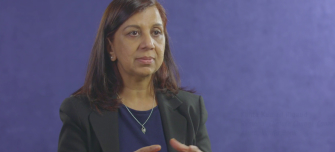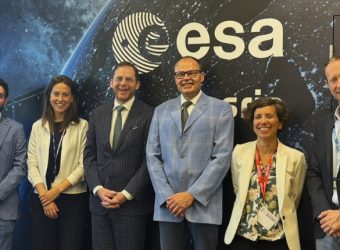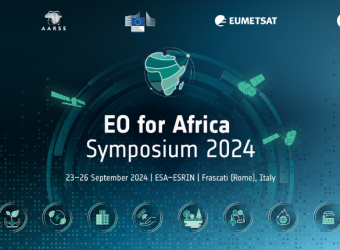In a significant step towards deepening collaborations, Bruno Carrasco, Director General of the Climate Change and Sustainable Development Department at the Asian Development Bank (ADB), visited ESA’s ESRIN centre in Frascati, Rome, on the 5th and 6th of September 2024. This two-day visit marked a pivotal moment in the long-standing partnership between ESA and ADB. Building on the progress made since ADB’s last visit in October 2023, this meeting sought to explore how Earth Observation (EO) can play a pivotal role in advancing ADB’s Strategy 2030, across all five of its strategic pillars, enhancing the effectiveness of their initiatives for sustainable development across Asia and the Pacific. One of the central themes of this strategy is the integration and application of digital technology to address many of ADB’s development challenges, with EO emerging as a fundamental enabler.
Long-standing partnership: EO for ADB’s core pillars and the shift towards knowledge intermediation
The strong collaboration between ADB and ESA has already yielded impactful results, leveraging EO for more informed decision-making in areas like disaster resilience, climate change, urban development, and sustainable agriculture. The meeting focused on further aligning EO capabilities with the findings of the mid-term review of ADB’s Strategy 2030, which focuses on five key areas: Climate Action, Private Sector Development, Regional Cooperation and Public Goods, Digital Transformation, and Resilience and Empowerment.
These areas will inform road maps for how the bank will transform in a rapidly changing development landscape, including sharpening the focus on EO technologies.
Opening the discussions, Bruno Carrasco emphasised ADB’s evolution from a traditional financial intermediary in the multilateral development sphere to a knowledge and financial intermediary. Investing in EO through the deepening of the ESA ADB partnership is an example of promoting the idea of a knowledge intermediary through digital technology, including EO, in addressing the development challenges across Asia and the Pacific. He also highlighted ADB’s Asian Development Fund (ADF), a concessional window that provides financial and knowledge support to developing nations. This shift toward knowledge intermediation marks a crucial transition for ADB as it seeks to leverage EO for climate action, regional cooperation and integration, and sustainable development.
ADB is keen to scale up its use of EO to support its strategic goals. “We’ve planted the seed,” said Paolo Manunta, Senior Digital Technology Specialist at ADB, “and now it’s time to grow this collaboration to its full potential.” The scaling-up of EO is central to ADB’s work in sectors such as energy, trade, and transportation, where digital and satellite technologies can provide critical insights to drive investment and policy decisions.
ESA’s expertise in satellite technology and data-driven insights – including open date access – allows ADB to make more precise, data-backed decisions, especially in regions where climate risks, urban growth, and natural resource management are critical challenges.
With Satellite EO based solutions we are responding to the demand for greater innovation while offering pathways toward more sustainable and resilient development.
Bruno Carrasco, Director General Climate Change and Sustainable Development Department at ADB
ESA’s commitment to EO solutions and climate long-term action
Rune Floberghagen, Head of ESA’s Climate Action, Sustainability, and Science Department provided an overview of ESA’s strategic role in the global space sector. At ESA, EO accounts for approximately one-third of the total budget highlighting the agency’s strong focus on climate solutions, innovation, and its collaboration with commercial space actors. ESA’s key priority is leveraging space technology for green solutions and supporting the global climate agenda.
As we scale our Earth Observation capabilities, we are unlocking new scientific frontiers that allow us to move from data collection to climate action. ESA’s role is pivotal in enabling large-scale, data-driven solutions that address both environmental challenges and economic resilience.
Rune Floberghagen, Head of ESA’s Climate Action, Sustainability, and Science Department
Rune emphasised that programs like ESA’s Global Development Assistance (GDA) are no longer just about development aid but are now integral to financing and supporting the green transition. Through GDA, ESA works closely with commercial service providers to ensure that the data and tools they offer are suitable for large-scale applications by International Financial Institutions (IFIs) like ADB.
In the subsequent discussions, attention was drawn to several key ESA initiatives, particularly those under the GDA programme. The ESA teams highlighted both ongoing and completed projects in collaboration with teams from the ADB, demonstrating the tangible benefits and long-term impacts of satellite EO technologies. The discussions underscored the transformative potential of these technologies in various sectors, showcasing how ESA’s efforts are driving meaningful change across the global development landscape. The dialogue covered a wide range of topics, including disaster management, enhancing climate resilience, promoting sustainable urban development, and advancing clean energy solutions. Notably, ESA also presented high-impact case studies from the GDA’s thematic activity on Fragility, Conflict, and Security, illustrating how EO is being applied to address complex challenges in conflict-affected and fragile regions.
Additionally, the ADB delegation visited ESA’s Phi-lab, a hub for cutting-edge innovation that aims to revolutionise industries through the application of emerging technologies. The Phi-lab’s mission is to bolster the competitiveness of the European EO industrial and research sectors on a global scale. During the visit, discussions centred around potential synergies between ESA’s innovations and ADB’s private sector operations. The teams explored opportunities for future collaboration, focusing on how these pioneering technologies can be leveraged to create impactful solutions within ADB’s project portfolio, particularly in sectors where private sector engagement is crucial.
EO as a cornerstone of ADB’s Inclusive Digital Transformation efforts
As ADB continues its efforts on effective utilisation of digital technologies to address development challenges in the Asia Pacific region, EO is being recognised as an essential component, e.g. for disaster risk reduction or intelligent agriculture. EO data provides a critical upstream resource, translating into actionable insights that drive downstream investments. This connection between knowledge and finance is central to ADB’s approach to regional integration, with EO supporting efforts in areas such as energy, trade, and transportation.
ADB is already exploring innovative digital tools, including the use of commercial platforms like CREODIAS and Cloud SEOS (Satellite Earth Observation System), to expand its EO capabilities. For ADB, EO is a critical part of the digital transformation wave sweeping across ADB member countries, facilitating both climate mitigation and adaptation.
Together with ESA we are retrieving spatially based information to better design our projects and fostering constructive dialogue with our Developing Member Countries.
Bruno Carrasco, Director General Climate Change and Sustainable Development Department at ADB
Furthermore, ADB’s Digital Technology for Development Division is focused on more than just basic GIS and EO operations—they are pushing the envelope in developing sophisticated digital public goods and geospatial tools. One exciting initiative is the Geo-Digital Sumatra project, a Digital Twin aimed at showcasing EO’s potential in helping Indonesia move toward carbon neutrality. This project is set to be presented to Indonesia’s National Development PlTanning Ministry (BAPENAS) as a model for other nations.

The meeting included an inspiring tour of ESA’s Φ-experience, offering participants a deep dive into the transformative potential of satellite Earth Observation technology. The tour provided a comprehensive look at how these cutting-edge technologies are harnessed to deliver critical insights across multiple sectors, such as disaster response, climate monitoring, and resource management. The ADB delegates were able to see firsthand how EO tools are shaping policy and decision-making processes globally, offering practical applications that address both environmental challenges and sustainable development needs.


Outlook on long-term engagement and action
As the partnership between ESA and ADB continues to evolve, both organisations are committed to pushing the boundaries of what EO technology can achieve. The discussions in Frascati set the stage for more ambitious projects in the coming years, reinforcing the value of space-based solutions for sustainable development.
This collaboration promises not only to enhance the effectiveness of ADB’s work but also to demonstrate the transformative potential of EO for international development.
As we continue to strengthen our partnership with ADB, we’re unlocking new opportunities for EO technology to drive sustainable development in ways previously unimaginable. Our collaboration is really about creating actionable insights that empower communities. Together, we’re demonstrating the true potential of space-based solutions to address the global challenges of today and tomorrow.
Christoph Aubrecht, ESA’s Global Development Assistance (GDA) Programme Coordinator

ESA’s GDA Programme is a global partnership implemented with key International Financial Institutions (IFIs), such as World Bank (WB) and Asian Development Bank (ADB), as well as International Fund for Agricultural Development (IFAD) and Inter-American Development Bank (IDB). Our goal is to mainstream the use of EO into development operations. For more information, please visit our website: https://gda.esa.int
















